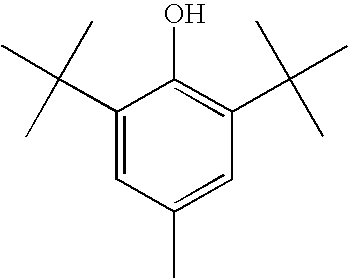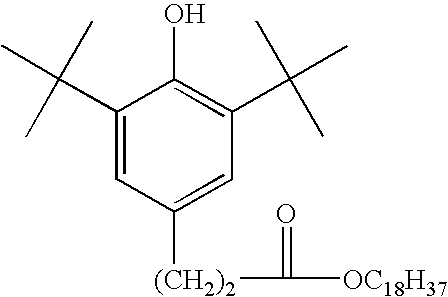Compositions comprising polyphosphonates and additives that exhibit an advantageous combination of properties, and methods related thereto
a technology of polyphosphonates and additives, applied in the field of compositions comprising polyphosphonates and additives that exhibit advantageous combination of properties, can solve the problems of low molecular weight polyphosphonates that exhibited poor toughness, insufficient general acceptance in the marketplace of polyphosphonates, and sacrifice of processability, so as to achieve good mixing and stabilization
- Summary
- Abstract
- Description
- Claims
- Application Information
AI Technical Summary
Benefits of technology
Problems solved by technology
Method used
Image
Examples
example 1
Synthesis of a Branched Polyphosphonate
[0059] The branched polyphosphonate was prepared according to the procedure in the published patent application entitled “Branched Polyphosphonates that Exhibit an Advantageous Combination of Properties, and Methods Related Thereto” (2004 0167284 A1, published Aug. 26, 2004, Ser. No. 10 / 374829, filing date Feb. 24, 2003).
[0060] A 250 mL, three neck round bottom flask equipped with a mechanical stirrer, distillation column, (10 cm) filled with hollow glass cylinders, condenser, and vacuum adapter with control valve was flushed with nitrogen for 0.5 hour. Methyldiphenoxy-phosphine oxide (44.57 g, 0.1795 moles), 2,2-bis(4-hydroxephenyl)propane (bisphenol A), (33.28 g, 0.1458 moles), tetraphenylphosphonium phenolate (0.0127 g, 2.77×10-5 moles) and 1,111-tris(4-hydroxyphenyl)ethane (0.460 g, 0.0015 moles) were placed into the flask and the flask was flushed with nitrogen again. The distillation column was wrapped with heating tape and heated. The...
example 2
Synthesis of a Branched Polyphosphonate
[0063] The branched polyphosphonate was prepared according to the procedure in the published patent application entitled “Branched Polyphosphonates that Exhibit an Advantageous Combination of Properties, and Methods Related thereto” (2004 0167284 A1, published Aug. 26, 2004, Ser. No. 10 / 374829, filing date Feb. 24, 2003).
[0064] In this example, the reaction was conducted in a pilot plant using methyldiphenoxyphosphine oxide (1400 g)—because this compound is 97.9% pure as determined by HPLC—the precise amount of this compound is actually (1371 g, 5.52 moles), 2,2-bis(4-hydroxyphenyl)propane (bisphenol A), (1308 g, 5.737 moles), tetraphenylphosphonium phenolate (0.451 g, 9.8×10-4 moles and 1,1,1-tris(4-hydroxyphenyl(ethane (6.4 g, 0.021 moles). The reaction was thermally treated following the protocol described in Table 1 as closely as possible.
[0065] Upon cooling, a near colorless melt was obtained. A 0.5% solution of the polymer in methylen...
example 3
Analysis of Branched Polyphosphonate Stability
[0066] The branched polyphosphonate of Example 1 with a relative viscosity of 1.38 was used in this set of experiments. The polymer without any additive was treated as follows: [0067] 1. melt in air / cool in air [0068] 2. melt under nitrogen / cool under nitrogen [0069] 3. melt and cool under vacuum
[0070] To melt the polymer, it was heated to approximately 250° C. for about 5 minutes. The relative viscosity was measured after each treatment. The results are presented in Table 3.
TABLE 4EFFECT OF TREATMENT ON MOLECULAR WEIGHTηrelηrelExampleTreatmentbeforeafter1melt in air / cool in air1.381.101melt under nitrogen / cool under nitrogen1.381.211melt and cool under vacuum1.381.38
[0071] The data in Table 4 indicates that without an additive, the branched polyphosphonate exhibits a reduction in solution viscosity, indicative of molecular weight reduction, upon thermal treatment in air or nitrogen. Since no degradation is noted when treated under v...
PUM
| Property | Measurement | Unit |
|---|---|---|
| dispersities | aaaaa | aaaaa |
| temperature | aaaaa | aaaaa |
| temperature | aaaaa | aaaaa |
Abstract
Description
Claims
Application Information
 Login to View More
Login to View More - R&D
- Intellectual Property
- Life Sciences
- Materials
- Tech Scout
- Unparalleled Data Quality
- Higher Quality Content
- 60% Fewer Hallucinations
Browse by: Latest US Patents, China's latest patents, Technical Efficacy Thesaurus, Application Domain, Technology Topic, Popular Technical Reports.
© 2025 PatSnap. All rights reserved.Legal|Privacy policy|Modern Slavery Act Transparency Statement|Sitemap|About US| Contact US: help@patsnap.com



